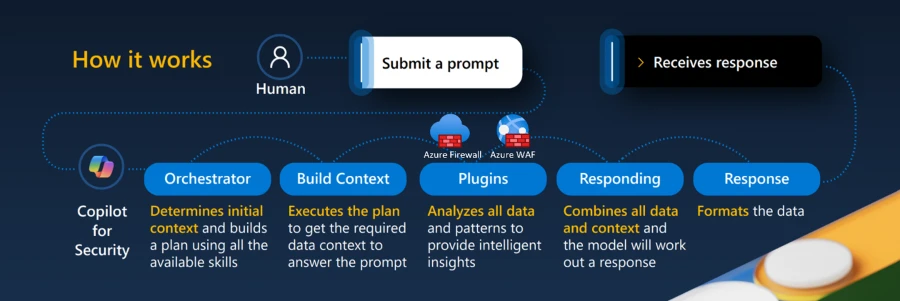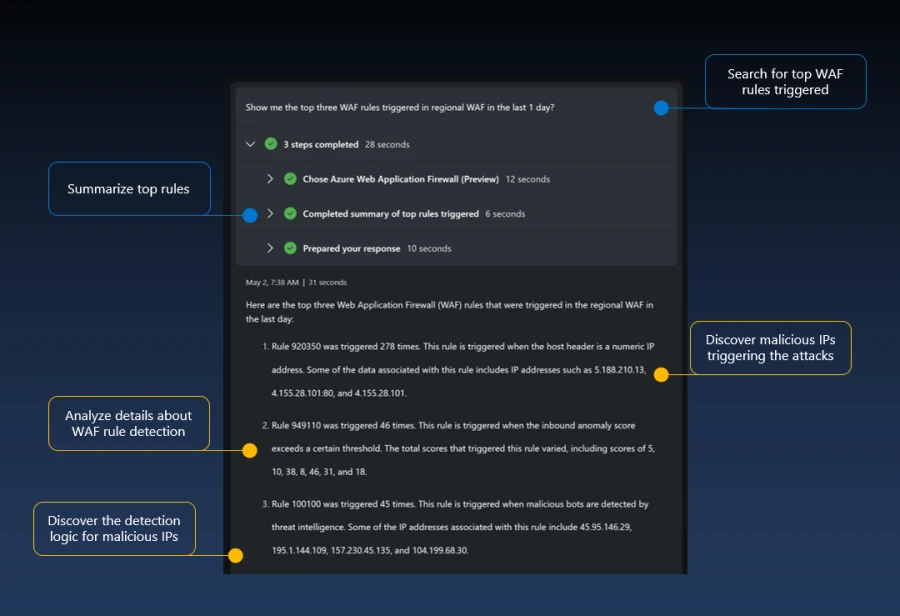In the present day we’re excited to announce the Azure Internet Utility Firewall (WAF) and Azure Firewall integrations within the Microsoft Copilot for Safety standalone expertise. This is step one we’re taking towards bringing interactive, generative AI-powered capabilities to Azure community safety.
Copilot empowers groups to guard on the pace and scale of AI by turning international risk intelligence (78 trillion or extra safety alerts), trade greatest practices, and organizations’ safety knowledge into tailor-made insights. With the rising value of safety breaches, organizations want each benefit to guard in opposition to expert and coordinated cyber threats. To see extra and transfer quicker, they want generative AI know-how that enhances human ingenuity and refocuses groups on what issues. A current examine exhibits that:
- Skilled safety analysts had been 22% quicker with Copilot.
- They had been 7% extra correct throughout all duties when utilizing Copilot.
- And, most notably, 97% mentioned they wish to use Copilot the subsequent time they do the identical job.

Azure community safety
Shield your purposes and cloud workloads with community safety providers
Generative AI for Azure community safety
Azure WAF and Azure Firewall are essential safety providers that many Microsoft Azure clients use to guard their community and purposes from threats and assaults. These providers supply superior risk safety utilizing default rule units in addition to detection and safety in opposition to subtle assaults utilizing wealthy Microsoft risk intelligence and automated patching in opposition to zero-day vulnerabilities. These programs course of large volumes of packets, analyze alerts from quite a few community assets, and generate huge quantities of logs. To cause over terabytes of knowledge and minimize by means of the noise to detect threats, analysts spend a number of hours if not days performing guide duties. Along with the size of knowledge there’s a actual scarcity of safety experience. It’s tough to search out and practice cybersecurity expertise and these employees shortages decelerate responses to safety incidents and restrict proactive posture administration.
With our announcement of Azure WAF and Azure Firewall integrations in Copilot for Safety, organizations can empower their analysts to triage and examine hyperscale knowledge units seamlessly to search out detailed, actionable insights and options at machine speeds utilizing a pure language interface with no extra coaching. Copilot automates guide duties and helps upskill Tier 1 and Tier 2 analysts to carry out duties that may in any other case be reserved for extra skilled Tier 3 or Tier 4 professionals, redirecting professional employees to the toughest challenges, thus elevating the proficiency of all the staff. Copilot may simply translate risk insights and investigations into pure language summaries to shortly inform colleagues or management. The organizational effectivity gained by Copilot summarizing huge knowledge alerts to generate key insights into the risk panorama permits analysts to outpace adversaries in a matter of minutes as an alternative of hours or days.

Azure Internet Utility Firewall integration in Copilot
In the present day, Azure WAF generates detections for a wide range of internet software and API safety assaults. These detections generate terabytes of logs which can be ingested into Log Analytics. Whereas the logs give insights into the Azure WAF actions, it’s a non-trivial and time-consuming exercise for an analyst to know the logs and achieve actionable insights.
The Azure WAF integration in Copilot for Safety helps analysts carry out contextual evaluation of the info in minutes. Particularly, it synthesizes knowledge from Azure Diagnostics logs to generate summarization of Azure WAF detections tailor-made to every buyer’s setting. The important thing capabilities embody investigation of safety threats—together with analyzing WAF guidelines triggered, investigating malicious IP addresses, analyzing SQL Injection (SQLi) and Cross-site scripting (XSS) assaults blocked by WAF, and pure language explanations for every detection.
By asking a natural-language query about these assaults, the analyst receives a summarized response that features particulars about why that assault occurred and equips the analyst with sufficient info to research the problem additional. As well as, with the help of Copilot, analysts can retrieve info on probably the most regularly offending IP addresses, determine prime malicious bot assaults, and pinpoint the managed and customized Azure WAF guidelines which were triggered most regularly inside their setting.

Azure Firewall integration in Copilot
Azure Firewall intercepts and blocks malicious site visitors utilizing the intrusion detection and prevention system (IDPS) function at this time. Nonetheless, when analysts must carry out a deeper investigation of the threats that Azure Firewall catches utilizing this function, they want to do that manually—which is a non-trivial and time-consuming job. The Azure Firewall integration in Copilot helps analysts carry out these investigations with the pace and scale of AI.
Step one in an investigation is to select a particular Azure Firewall and see the threats it has intercepted. Analysts at this time spend hours writing customized queries or navigating by means of a number of guide steps to retrieve risk info from Log Analytics workspaces. With Copilot, analysts simply must ask in regards to the threats they’d wish to see, and Copilot will current them with the requested info.
The subsequent step is to raised perceive the character and influence of those threats. In the present day, analysts should retrieve extra contextual info equivalent to geographical location of IPs, risk score of a totally certified area identify (FQDN), particulars of widespread vulnerabilities and exposures (CVEs) related to an IDPS signature, and extra manually from numerous sources. This course of is sluggish and entails quite a lot of effort. Copilot pulls info from the related sources to counterpoint your risk knowledge in a fraction of the time.
As soon as an in depth investigation has been carried out for a single Azure Firewall and single risk, analysts wish to decide if these threats had been seen elsewhere of their setting. All of the guide work they carried out for an investigation for a single Azure Firewall is one thing they must repeat fleet large. Copilot can do that at machine pace and assist correlate this info with different safety merchandise built-in with Copilot to raised perceive how attackers are focusing on their whole infrastructure.

Trying ahead
The way forward for know-how is right here, and customers will more and more count on their community safety merchandise to be AI enabled; and Copilot positions organizations to totally leverage the alternatives offered by the rising period of generative AI. The integrations introduced at this time mix Microsoft’s experience in safety with state-of-the-art generative AI packaged collectively in an answer constructed with safety, privateness, and compliance at its coronary heart to assist organizations higher defend themselves from attackers whereas conserving their knowledge utterly non-public.
Getting entry
We look ahead to persevering with to combine Azure community safety into Copilot to make it simpler for our clients to be extra productive and be capable to shortly analyze threats and mitigate vulnerabilities forward of their adversaries. These new capabilities in Copilot for Safety are already getting used internally by Microsoft and a small group of shoppers. In the present day, we’re excited to announce the upcoming public preview. We count on to launch the preview for all clients for Azure WAF and Azure Firewall at Microsoft Construct on Could 21, 2024. Within the coming weeks, we’ll constantly add new capabilities and make enhancements primarily based in your suggestions.
Please cease by the Copilot for Safety sales space at RSA 2024 to see a demo of those capabilities at this time, specific curiosity for early entry, and examine extra Microsoft bulletins at RSA.

